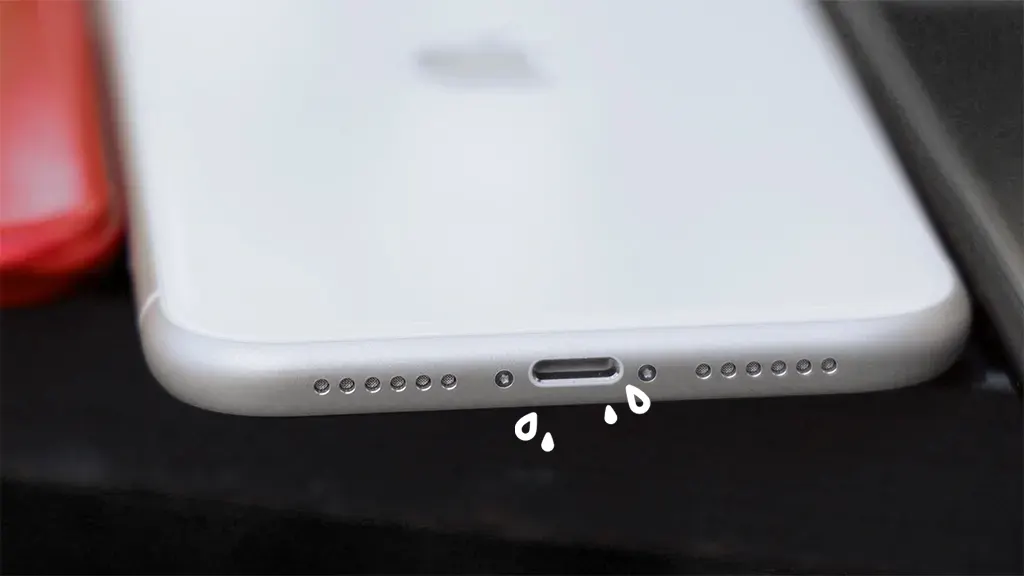What to do if iPhone says liquid detected in Lightning port

If you've seen the "liquid detected in Lightning® connector" warning pop up on your iPhone®, you may be wondering what that means—and whether your phone is broken. Don't worry, we'll walk you through what's going on and explain exactly what to do.
At Asurion, we troubleshoot your tech and appliance issues to keep the devices that run your world going, from what to do if your iPhone isn't charging to how to extend the life of your phone. Think of us as your own personal gurus, available 24/7. Here are a few things you can do if you see a “liquid detected" message on your screen.
What does “liquid detected in Lightning connector" mean?
The “Liquid detected in Lightning Connector" message will appear on your screen if your phone senses liquid in the Lightning port, the slot at the bottom of your device where you plug in your charger. It will also appear if your phone senses excessive liquid in an accessory that connects to the port, such as a speaker or a pair of headphones.
How to get water out of your iPhone Lightning port
Your iPhone is built to withstand liquid damage, and depending on the model, it may even be waterproof or water-resistant (to understand the difference, check out our guide). Either way, that's good news for you—and your phone—if you accidentally spill a drink on it or drop it in the pool.
If your phone does get wet and you have water in the iPhone charging port, you need to dry it out to avoid damage. The only reliable way to do so is to give it time to dry. Follow these steps to dry your phone properly:
- Make sure your phone is disconnected from any cables, including its wired charger.
- Gently tap the phone with the Lightning connector facing downward to help coax any liquid out of your device.
- Leave the phone in a dry area with sufficient airflow for at least 30 minutes. Then connect it to a Lightning cable or another accessory to see if the “liquid detected in Lightning connector" message still appears.
- If you still see that message, there is still liquid in the Lightning port or under the pins of your Lightning cable's connector. Repeat the previous steps, but allow your iPhone to dry for longer and then test it again with a charger or accessory. If the problem continues, leave your phone to dry for 24 hours before testing it again.
If you've tried these steps and still need a little help, we're right around the corner. Schedule a repair at the nearest uBreakiFix® by Asurion store and our certified experts can get your device back up and running as soon as the same day.
What not to do with your wet iPhone
We get it—when your phone isn't working, you may want to try anything to get rid of that dreaded liquid detection alert. But there are a few things you don't want to do when trying to dry your iPhone's charging port—all can damage your device's internal components.
- Don't dry your iPhone by using an external heat source, like a hair dryer, or compressed air.
- Don't insert a foreign object, like a paper towel or a cotton swab, into the lightning connector.
- Don't put your iPhone in a bag of rice - but silica gel packets can actually help.
Should you use emergency override mode?
Using your charger while the iPhone is still wet can cause permanent damage to your devices and accessories. But if it's an emergency, you can override the liquid detected in lightning connector message and charge your phone. You can do so by removing the charging cable and then re-inserting it. The same “liquid detection" message will appear, but you'll now have the option to tap Emergency Override and charge your phone.
If you have a wireless charger, we recommend using that instead of plugging your phone into a socket to avoid further damage in the lightning port. Just make sure the back of your device is dry before you try charging it wirelessly.
The Asurion® trademarks and logos are the property of Asurion, LLC. All rights reserved. All other trademarks are the property of their respective owners. Asurion is not affiliated with, sponsored by, or endorsed by any of the respective owners of the other trademarks appearing herein.
- SHARE THIS ARTICLE